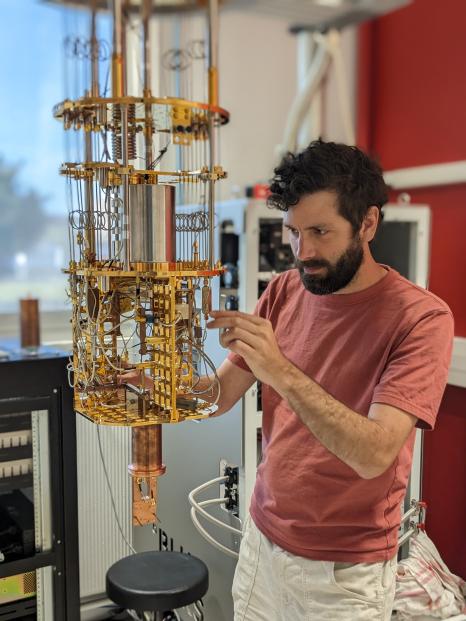
Emmanuel Flurin: When quantum technologies play with the laws of the Universe
Emmanuel Flurin is a researcher at the Condensed Matter Physics Laboratory (SPEC - Univ. Paris-Saclay, French Alternative Energies and Atomic Energy Commission CEA, National Centre for Scientific Research CNRS) and specialises in quantum physics. With his team at the Quantronics group, a pioneer in superconducting circuits, he has just developed the world's most sensitive power sensor, pushing the limits of magnetic resonance.
Quantum information has been exciting the scientific and industrial worlds for the past thirty years. "Today, to describe most physical phenomena at the atomic scale, we use the language of quantum computing, based on the qubit," describes Emmanuel Flurin. Unlike the bit in traditional computing, which only takes two states or values (0 or 1), a qubit (or quantum bit) consists of a superposition of these basic states: "It's a hybrid object between analogue and digital that very effectively describes nature at its most fundamental level."
This mathematical wealth is what makes quantum information so interesting to manipulate, and explains the current craze for quantum computers, which promise to process calculations that are beyond the reach of current computers. "The description of the Universe, which has a fundamentally quantum operating system, becomes much simpler and more compact. For example, to describe a molecule of twenty atoms, I only need a few dozen qubits instead of terabits (1012 bits) on a standard machine."
The world's most sensitive sensor
At SPEC, Emmanuel Flurin designs quantum chips. One day, he and his team had the idea of diverting a superconducting chip from its primary purpose; they transformed a device initially designed for the burgeoning quantum computing industry into a super-powerful sensor, sensitive to the fluctuations of the electromagnetic field above the quantum vacuum, reached at temperatures approaching absolute zero (0 K).
Emmanuel Flurin and his team are now using this quantum sensor to probe matter at unprecedented sensitivities. Working with an Italian cosmology team, they are looking for traces of dark matter. "Axions are hypothetical particles that envelop our galactic halo. They would explain the missing mass of the Universe, but also a curiosity of the Standard Model: the cancellation of an expected term with a precision of 10 decimal places. By interacting with a strong magnetic field generated in the laboratory, the passing axions should disintegrate in the form of a microwave photon. So far, there's no sign of it, but you have to be patient! It's a long-term hunt," explains the researcher.
The team is also using this detector for spin magnetic resonance, the best-known application of which is medical imaging (MRI). This is electron spin detection at its ultimate sensitivity. Recently, this has led to the visualisation of individual electrons. "These new quantum sensors allow us to see the granularity of radiation and matter in new ranges of the electromagnetic spectrum, those of microwaves, wireless telecommunications and also MRI. This is a fundamental physics discovery that will undoubtedly lead to applications in the medium term."
Electron spin and single photons
The physics principle on which the experiment is based is as follows: electron spin is a two-level system, an elementary magnet immersed in a strong magnetic field, which can be described by two states. In its ground state, the spin aligns with the field like a compass. In its excited state, it is anti-aligned. Magnetic resonance describes the transition from one state to another via the absorption or emission of photons whose energy is in the microwave range.
The aim of the experiment is therefore to prepare a single spin in its excited state and capture the single microwave photon produced when it de-excites. Since de-excitation only occurs spontaneously after a very long time, it is accelerated by using a superconducting resonant cavity. The emitted photon is then collected by the microwave photon counter, consisting of a superconducting qubit capable of irreversibly absorbing the photon. "By exploiting superconducting quantum circuits, we have gained thirteen orders of magnitude over commercial magnetic resonance instrumentation. It's a great demonstration of the power of quantum technologies."
In addition to funding from the French National Research Agency (ANR) in 2018 and an ERC Starting Grant in 2021 for the Ingenious project, these world firsts have resulted in two publications in the journal Nature.
Research: craftsmanship of excellence
"Academic research is quite similar to high-technology craftsmanship. It takes four years, which is equivalent to producing a thesis, to master the experimental cycle from A to Z. We design unique, customised artefacts. We draw their plans, manufacture them piece by piece, assemble them, and after many weeks, install them in cryostats and connect them to state-of-the-art sensors. And when the measuring begins, we look for the flash of the artefact, the reflections of fragile physical effects that only manifest themselves under certain conditions. Often, the much-hoped-for flash doesn't appear, and we start all over again. Sometimes, the effect is there, hidden in the data, and we spend weeks unearthing it, contemplating it and then describing it in all its facets. It's a flash never seen before and a reward for physicists. We then write a publication to share the discovery, submit a patent to protect the invention, and start again, heading a little further into the unknown."
Reaching the quantum Holy Grail
Scientists around the world are racing to bring humanity into this new quantum era. Two paths are open to them. On the one hand, there are start-ups generously financed by industry, with clearly defined objectives; on the other, academic research, largely encouraged by various national programmes. Emmanuel Flurin does both at the same time: he is involved in the work of the start-up, Alice et Bob, while also dedicating himself to his academic research. "This provides a certain degree of freedom to explore different scientific directions. It is the breeding ground for future start-ups, which may come to fruition in ten years' time."
Passionate about physics, Emmanuel Flurin remembers his fondness for popular science journals and his childhood desire to become a researcher. After studying engineering at EPSCI-PSL and completing a thesis on superconducting circuits at ENS in 2014, he spent three years as a post-doctoral fellow at the University of California, Berkeley. Recruited by the CEA on his return to France in 2018, he now teaches at Université Paris-Diderot and École des Mines de Paris.
Winner of the Jacques Herbrand Grand Prix 2022 awarded by the French Academy of Sciences, he is delighted to have contributed to the scientific excellence of French quantum physics, particularly at the CEA and Université Paris-Saclay. "We're listened to around the world because of the quality and originality of our work", says the researcher, who hopes to capitalise on the alliance between schools and universities on the Plateau de Saclay to create a cluster of students who excel in quantum physics and are interested in coming to work in the Plateau's many laboratories.

